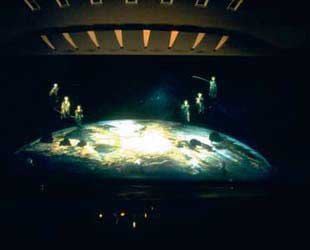| HOME | PROFILE | HIS WORLD | COSMIC SPACE | LORD OF THE RINGS | PAINTING WITH LIGHT |
'You know,
for me,
celestial bodies
have had,
ever since
my early childhood,
a really uncommon
and extraordinary
meaning.
I often stood
and looked towards
the heavens above,
not very consciously
and almost
dream-like.
How could there be
so many?
And I thought to myself:
What is the significance
of each of these bodies,
do people live on them?
How do they relate
to the earth?'*
 Orff's Comedy
from the End of Time is an orphan work, largely ignored by the musical
world. Yet Schneider- Siemssen considers it one of the most important in
his career.
Orff's Comedy
from the End of Time is an orphan work, largely ignored by the musical
world. Yet Schneider- Siemssen considers it one of the most important in
his career. To him, Orff's last work contains, in its music and text, "...the entire drama of mankind. Like an artistic last will and testament, which Orff wanted to leave us. I was chained to this task; here I could fashion the stage completely as a cosmic space. The "Fortunetellers," the "Wise Men," the "Last People," and the impression of the end of the world - I presented this and I soon discovered it was Orff's vision and wish as well." *
The work received its first presentation at the Salzburg Easter Festival in 1973, with Herbert von Karajan conducting and August Everding directing. The stage designs made extensive use of projections of abstract images, leaving the audience with an overwhelming impression of the cosmic. For the first time it was noted that Schneider-Siemmsen was not necessarily the realistic stage set designer it had thought him to be. Orff composed the work near the end of his days. Perhaps premonitory in its vision of the end of the world, it left the audience with a sense of gloom - which is probably one reason why the first presentation has to this date also been the last. Yet it remains very dear to Schneider-Siemmsen's heart.